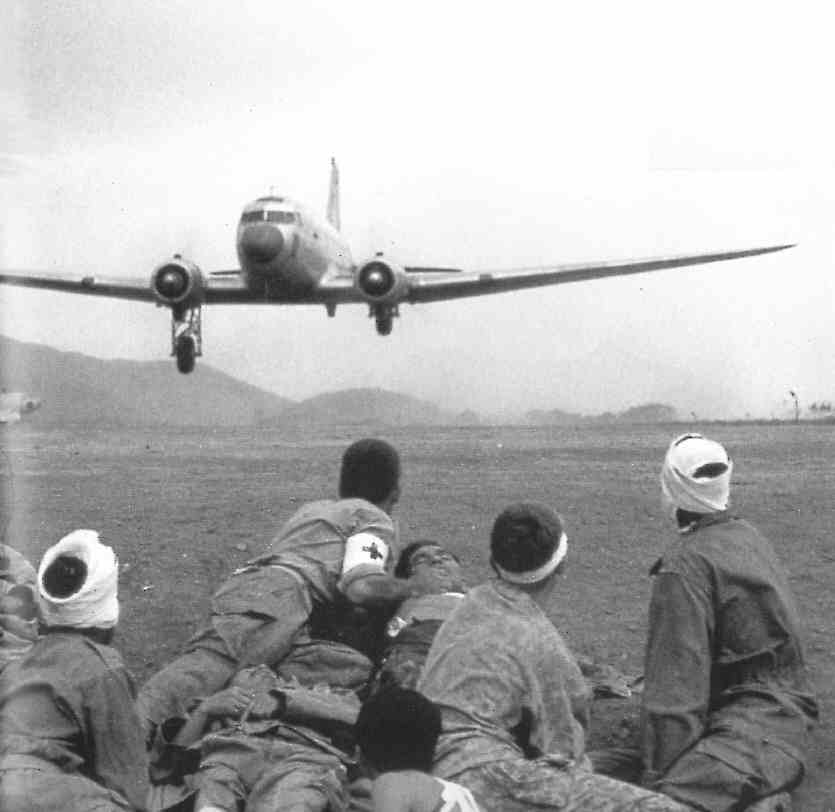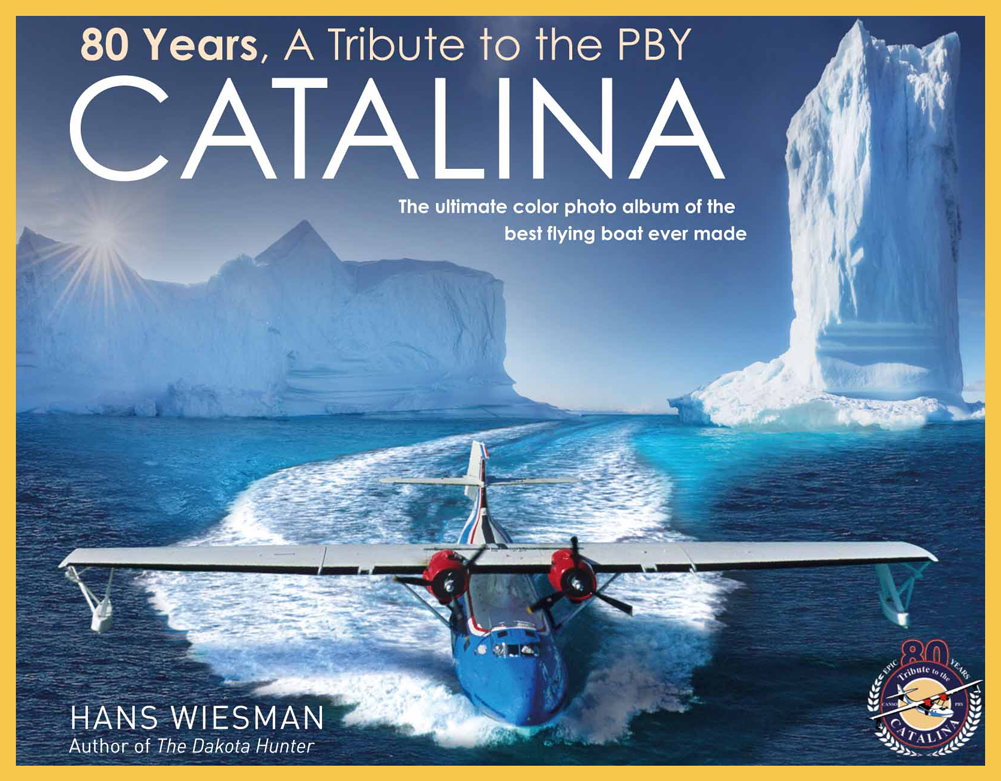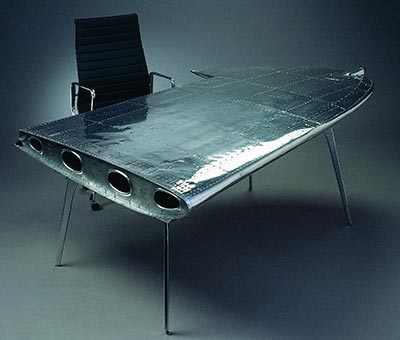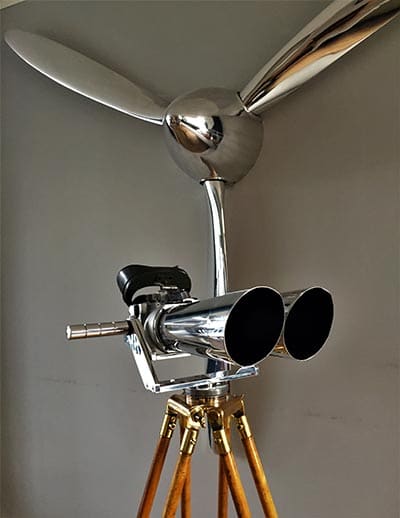French C-47’s Last Flight out of Hell, Dien Bien Phu, Vietnam 1954.
Intro
In 1954, it was 9 years ago that WWII had come to an end, and the Korean conflict had just ended in 1953. Many USAF surplus C-47’s war veterans were flown over from Korea to the next Communist threat in the Cold War, Vietnam.
Here the C-47/ Dakota would meet yet another War Theater and become very active as a versatile transport for the French Military and later (as seen in this impressive photo) in their Flights of Relief for the wounded soldiers. Rugged and reliable, it could fly anywhere, any time, even when under fire from AA guns and small arms.
With the French troops’ defeat coming to a fatal close in April 1954, almost 70 Douglas C-47s did overtime to fly in and out of the besieged Army camp Dien Bien Phu. Bringing in food, ammo, and medical supplies, on the way out, they flew to the South hundreds of wounded soldiers from this Jungle Hell in the Western mountains of Northern Vietnam.
It was an airstrip built by the Japanese during WWII and was selected in 1953 by the French Army as a stronghold against the advancing nationalist Viet Minh forces. Their Commanders, the legendary General Giap and leader Ho-chi- Minh, challenged the Colonial rule of the French right after the Japanese defeat in 1945.
Under General Navarre’s command, French forces decided, against all odds, that holding Dien Bien Phu was a major strategic objective. It was a controversial decision. But the French fortified the position with over 30,000 soldiers.
It will remain forever a disputable decision as to why the French, under the pressure of the Nationalist Rebels’ growing strength, opted to occupy such remote venue. That was in the heart of an enemy ruled territory, which could only be supplied with long flights from the South-East. Moreover, the place had no real strategic value in that mountainous outback. Soon, the French troops would find out and go from one surprise to the next disaster.
This photo of one of the Last Flights Out of the Dakota from Dien Bien Phu made a miraculous escape with many wounded soldiers on board. The aircraft came under heavy fire. Shortly after that, the airstrip was overrun by the very determined Vietnamese troops. I saw this pic as a young boy in LIFE Magazine in 1954. It would forever remain printed in my memory. Living in Borneo in a similar remote Jungle, our only way of transport to get us out to safety was that C-47/Dakota (or a PBY Catalina). Our only escape route in case it ever would go wrong out there with the Commie infiltration. Can you believe that this DC-3 became my Poster Hero?
Photo 2: Viet Minh troops slowly squeezed the French Forces to a humiliating surrender. In the final stages, it was only the Dakota that still could fly in and out from the short airstrip with 3 tons of cargo for supplies and transport of wounded soldiers.
As the Vietnamese troops also started to operate Russian AA guns, the landings became very dangerous, even by night, and had to be stopped for obvious reasons.
Never underestimate your enemy.
Once French Airborne troops occupied the field, the battle that laid ahead must have taken the French by total surprise, mainly due to what the enemy could deploy as a counterforce. With 50.000 troops, the Viet Minh Army stealthily dug in on the surrounding jungle-covered hills that overlooked the lower-situated French Army camp and Landing strip.
A bad starter, but worse, the Vietnamese had done the impossible by transporting over 300 km their heavy artillery, howitzers, and guns for their final assault on the well-defended French camp. That was done with basic but massive human force and bicycles, bringing the dis-assembled heavy weapons over Jungle trails into remote mountain-positions. No French Army General or Patrol would ever have imagined that such could happen without a serious Air- or Truck-lift.
It was possibly underestimated that the Viet Minh had acquired such a load of heavy artillery, supplied by the USSR and/or China over the long common border in the North. Genius strategist Giap could switch from a Guerilla War to a classic battle of Armies or a siege with such hefty equipment, and he would repeat that trick many more times in the later escalation in the 1960s against the US Army.
Last flight out of Hell.
Once the shooting started, the French Artillery, with 105mm howitzers and 155mm guns, could not neutralize the well-hidden enemy firepower that also changed their gun position very frequently. The daily supply flights that came in to bring ammo and food (with on the return flight the Medivac role to transport the wounded) were soon made impossible as the Vietnamese activated their Russian made AA 37mm guns from the surrounding hills.
The Photo shows French Pilots discussing a flight plan over a map, sitting under a war-weary F-8F Bearcat with battered jettisonable underwing fuel tanks. The limited number of French fighters could never stop the invasion of the Viet Minh. Such would require the engagement of a fleet of long-distance Bombers, that only the USAF could deploy over that region. But, allegedly, they refused to engage in this “Colonial” War. Less than 6 years later, they were engaged in that ongoing conflict that got a new name: an Imperialist-War. Change of name, same country, same sort of Guerrilla war mixed with classic battles, now Communists against the Free World.
The photo depicts the preparations that French Forces made in anticipation of the Viet Minh attack with the digging of trenches and barbed-wire fences. In the background, we see the airstrip with what seems a Curtiss Commando C-46 in the center and a C-47 in the right upper corner. Hidden in the mountains seen in the backdrop, that is where the Viet Minh had its heavy artillery positions, being a complete surprise for the French how they ever got there.
The C-47’s last flight out came under heavy attack from guns and AA fire, and that must have been a most harrowing flight for all on board, but they made it to escape in an epic “Last flight out of Hell.”
From there, the supply of food, ammo, and fuel to the French could only be done with Para- droppings by more than 50 C-47’s and 12 C-119’s Flying Boxcars. The Americans supplied all aircraft and weapons—most of it coming from the Korea Conflict that ended a year before in 1953.
But with all that superiority in the supply chain, flying in every day, the Drop zone became smaller, and the pressure higher on the originally 30.000 French troops consisting of Army, Legionnaires, Paratroopers, and Colonial Forces from North Africa as well as French Vietnamese soldiers and local T’ai Tribal forces.
In a final attempt to turn the tide, French generals allegedly begged the USAF to come to the rescue and start massive bombing raids of the surrounding hills, to neutralize the Viet Minh Guns and wipe out the swarms of troops, all eagerly waiting for the signal to attack the French camp.
The French Camp overrun.
By the 7th of May 1954, the Apocalypse’s Day was closing in; the Viet Minh troops overran the French camp. To the dismay of the Western World, almost 12.000 French troops were taken prisoner-of-war after the surrender: they were forced to make the ‘Walk of Shame’ over 300 km, and most of them never returned from that agony. A nightmare scenario for the Western Powers of which many still had Colonial Rulings in countries in Asia and Africa.
Photo 3: It was the beginning of the end of the French Colonial Rule of 100 years over Vietnam. And there was worse to come in the second Vietnam War (1960-1975) with the USA getting involved in this escalating conflict.
Here is another dramatic picture of the Vietnamese troops as they took over and made their Dance of Victory on a burnt C-47.
The first Indo-China War had come to its finale and brought an end to 100 years of French Colonial Rule in SE Asia. The world may have thought that 10 years after the end of WWII, finally, Peace would have settled in this region. But the second Indo-China War was only just about to begin.
Strangely enough, that was the conflict which dragged the (anti-colonial but also anti-communist) USA in. That war would finally end 20 years later, with a “Peace” treaty signed in 1975 in Paris. In both conflicts of 30-years duration, the WWII workhorse C-47 would play an interesting role.
The glorious role of the C-47, a WWII-Veteran that soldiered on in Korea and Vietnam, what’s next?
Not widely known, but most of the surviving USAF C-47’s were not flown home in 1975, but the war-weary veteran aircraft (all well over 30 years of age) were flown to Thailand and joined the Royal Thai Air Force for many more years. Thailand was considered by many as becoming the new Theater of War for the Chinese. After the Vietnam-War ended in 1975, they were believed to concentrate on Thailand as the next target in their Domino strategy to dominate SE Asia.
But history took a different path; China (and Vietnam) opted for the more lucrative Workshop-of-the-World role and adopted a more peaceful strategy. But China and Vietnam have no longer very close ties, while Vietnam is in a good (business-driven) relation with the USA, both trying to ward off the ever-more aggressive Chinese expansion in the SE Asian Seas.
The Douglas C-47s had their final career in the RTAF with another 20 years of operations until they were out-phased in the mid-1990s and were stored on the RTAF bases and the Royal Navy AFB. After years of neglect, the now derelict war veterans came to their final glorious act. By 2008, five of them were transported to the Phuket Island and planned to be buried in a sea grave: a Diver’s Paradise created around an artificial reef, with 5 C-47s and a dozen Helicopter wrecks.
One day, the Dakota Hunter was invited to come to Phuket to make a deal. I had a most intriguing confrontation with the aircraft and their self-proclaimed owners, the Military, and the authorities. Read my fascinating chapter in this book, “The Eve of Destruction, the Phuket sinking of C-47s!”











